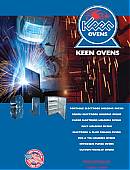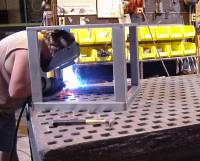Industrial Ovens
Front-Loading
![]() Under 10 cubic feet
Under 10 cubic feet
![]() 10-20 cubic feet
10-20 cubic feet
![]() Over 20 cubic feet
Over 20 cubic feet
![]() See All
See All
Top-Loading
![]() Under 10 cubic feet
Under 10 cubic feet
![]() 10-20 cubic feet
10-20 cubic feet
![]() Over 20 cubic feet
Over 20 cubic feet
![]() See All
See All
Learn About Our Industrial Ovens
Welding Ovens
![]() CONEX Storage
CONEX Storage
![]() Stick Electrodes
Stick Electrodes
![]() Sub-Arc Flux
Sub-Arc Flux
![]() Wire Spools
Wire Spools
![]() Tig Filler Wire
Tig Filler Wire
![]() Multi-Purpose
Multi-Purpose
![]() Nitrogen Purge
Nitrogen Purge
![]() See All
See All
 Order Our Free Catalog Today Click Here |
| Available Inventory |
Stick Welding - Shielded Metal Arc Welding
Out in the shop or field it's Stick, Mig, and Tig. Stick welding uses a consumable rod, or electrode. The rod is short circuited at the end causing great heat, which in turn melts the end of the rod into tiny molten droplets. These droplets form the weld pool which melts into the base, or parent metal. Some rods penetrate, or fuse deeper into the metal than others. Click here to view our welding ovens and to learn about the benefits of proper storage! Fusion
is actually the correct word for how deep the weld pool goes into the surface
of the base metal. Penetrate means how far the weld pool goes into or through
a joint, although welders in the field usually use penetrate for both. Porosity, cracking, and slag inclusion (slag that hasn't been chipped/brushed welded over and becoming part of the weld) are three major weld defects. Around World War II, it was noticed that a rusty rod actually performed better than the brand new bare rods used in welding. After experimenting with elements such as silicon, potassium, and others, it was discovered that adding a flux coating to the bare electrode formed a gas which kept the atmosphere out of the weld pool. The slag would then solidify and form a protective coating around the weld which would later be chipped off and brushed clean. Cleanliness is of utmost importance in all welding processes! Although aluminum and other metals can be stick welded, most common stick welding is done on mild steel and stainless. Cast iron can be stick welded, but requires pre-heating and post-heat cool down with a high degree of skill level. Some advantages of stick welding are:
Some disadvantages of stick welding are:
In most structural construction, stick welding is done with 7018 low hydrogen, and 6010 rods. An easy rod to start out with is 6013. This is primarily a rod used to stick weld thin surfaces such as sheet metal. It is a drag rod, meaning that you need only to drag it on the surface of the steel as you weld. Oscillation and manipulating the rod up and downwards slightly as you weld will help wash the weld pool into the base metal, and produce a good looking weld. Learn More About Stick Electrodes! |
 The technical name for
stick welding is Shielded Metal Arc Welding, with the acronym SMAW. Mig welding
is now referred to as Gas Metal Arc Welding, or GMAW. Tig, or Heliarc welding
is now Gas Tungsten Arc Welding, or GTAW.
The technical name for
stick welding is Shielded Metal Arc Welding, with the acronym SMAW. Mig welding
is now referred to as Gas Metal Arc Welding, or GMAW. Tig, or Heliarc welding
is now Gas Tungsten Arc Welding, or GTAW.